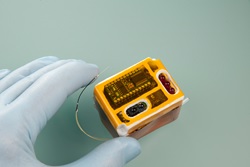 |
| A wearable drug delivery device designed to treat hearing loss--Courtesy of Draper Lab |
A new miniaturized wearable device has shown potential in the delivery of drugs to the inner ear that could someday treat hearing loss in a less invasive way than via constant injection.
Researchers at Draper Laboratory in Cambridge, MA, published in the Royal Chemical Society's journal Lab on a Chip their progress in creating the small intracochlear device designed to treat sensorineural hearing loss. The wearable device could treat the noise-induced condition and other inner-ear diseases by delivering drugs into the fluid of the inner ear, bypassing the usual injections, according to an announcement from Draper.
In collaboration with the Massachusetts Eye and Ear Infirmary, Draper's team is designing the device to be used with drugs currently in development for hearing loss.
The device has a drug reservoir that works in a way specific to the ear; as it pushes drugs out, it maintains crucial pressurization in the ear by drawing other fluids in. The researchers have tested the device both in vitro and in vivo with successful results, and the next step will involve long-term testing, as well as further miniaturization.
The National Institutes of Health funded the project through its own National Institute on Deafness and other Communication Disorders.
"This is a major step toward the future miniaturization that will be required for an implant for humans, because it shows the approach we will use as we go forward and has the potential for further size reduction," said lead investigator Jeff Borenstein of Draper Laboratory.
- here's the release
- see the research abstract